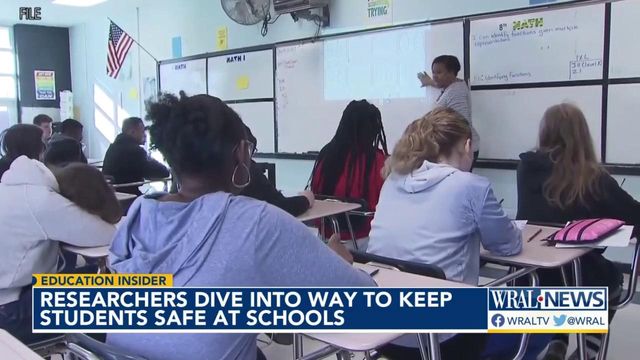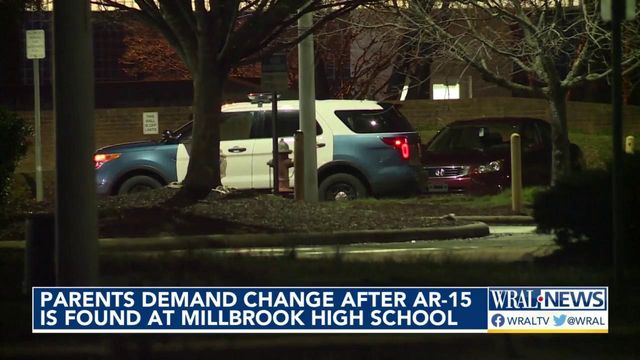Tip lines, door locks and detectors: What works, and what doesn't, in school safety, according to several experts
As gun violence rises, schools are still one of the safest places for children to be. But high-profile incidents involving guns on campuses are prompting school systems to investigate the best ways to beef up security.
Posted — UpdatedNot every school system will do the same — some don’t have the financial wherewithal, others may choose a different tack. In the end, experts say, school systems have to make their own cost-benefit analyses to determine the best way to spend their money to make the biggest improvement to school safety.
An influx of new state funds for safety measures, appropriated by the North Carolina General Assembly, is helping school systems afford some measures more easily. But as pressure grows and dollars flow, schools need to be diligent in determining which products and systems to buy — and vigilant of too-good-to-be-true tech, said Jaclyn Schildkraut, a professor at State University of New York Oswego who also works with the Regional Gun Violence Research Consortium, a group that provides research to policymakers.
“This is where we see sort of this idea of security theater,” she said. After mass shootings, such as the one last year in Uvalde, Texas, that left 19 students and two teachers dead, “we see everybody come out of the woodwork trying to sell a product. … There's no evidence to suggest that they're going to do anything. They're largely reactionary, and most of them actually aren't even to prevent the shooting.”
For example, bulletproof glass could stop a bullet from going through that window, but it won’t stop a shooter, she said. Students have found ways around other measures, such as clear backpacks and metal detectors, especially if the metal detectors aren’t staffed at all times.
Research on the effectiveness of metal detectors at schools is scant. And researching the effectiveness of the devices is challenging because it’s difficult to know what deters people from any action, according to Pauline Moore, a professor who studies school safety at Pardee RAND Graduate School in Santa Monica, California.
However effective or ineffective the systems are, many parents argue that the technology is worth it if it can stop some weapons or save one life.
It’s difficult to know whether a metal detector would have caught the AR-15 that was smuggled into a basketball game Thursday at Millbrook High School. Police are investigating how the weapon made its way into the gym where Millbrook was playing a playoff game against Hillside High School. At least 10 guns have been seized at local schools, including Millbrook, in the past month.
A gun carrier’s intent could render any technology moot. “If someone walks into a school brandishing a rifle [and] intends on committing mass murder, metal detectors will do nothing to stop that,” said Conor Healy, director of government research at IPVM, a security technology research group. “In fact, they're mostly irrelevant once the situation is at that point.”
As schools face public pressure — on top of existing budgetary constraints — they’re looking at what they can afford that will make the biggest difference.
Schildkraut and others say several measures can help prevent school shootings:
- Anonymous tip lines, which most North Carolina school systems already operate, can help students feel more comfortable reporting warning signs or threats. Those systems need to be backed up by teams of staff ready to respond to those reports.
- Training, particularly for staff, on recognizing warning signs.
- Doors that can be locked from the inside.
- Preventing and curbing bullying by fostering better relationships between students and improving the mood at school.
- Parents practicing safe gun storage at home, keeping guns out of their children’s hands.
- Minimizing publicity of unsubstantiated threats and of shooters’ names to prevent copycat threats or shooters. Both often occur in clusters.
Preventing violence
Paul Smokowski, a researcher with the North Carolina Youth Violence Prevention Center, said bullying is the biggest safety concern at schools and can be a precursor for deadly violence.
Prevention efforts centered on stronger social and emotional development for students can help by enhancing trust and connectedness in the school community, said Hsing-Fang Hseih, a research assistant professor and the Institute for Firearm Injury Prevention at the University of Michigan. Working through conflicts with students together can help, too, she said.
“And we have evidence for youth empowerment — How do we engage youth in creating this positive climate, in preventing violence?” she said. Some after-school programs have shown promise.
But bullying rates haven’t been going down, Smokowski lamented. Schools simply face too much of it for the limited number of adults they have in the buildings. Anti-bullying efforts that work may require an investment of staff and time to work with individual students.
Experts have mixed opinions on how effective lockdown drills and school resource officers are. Schildkraut favors lockdown drills, because they keep people prepared in case a shooting ever occurred. But Smokowski said they can end up leaving students more fearful of being at school, especially if they are coupled with simulations of a mass shooter event.
Smokowski noted schools can use Medicaid funds to help them provide mental health services to students on campuses. Most school systems in North Carolina are Medicaid providers now, and Medicaid billings have risen sharply since the mid-2000s.
Both experts noted that in many cases, students bring weapons to school without intending to use them at school. They might bring them to show off to classmates or for self-defense on their way to and from school.
Children are most likely to die from gun violence at home or in their own neighborhoods, Schildkraut said.
How safe are schools?
Schildkraut, Smokowski and Hseih each said schools are relatively safe places and noted that — despite the high-profile nature of school safety — mass shootings are highly unlikely to occur.
Mass shooting deaths account for about 0.1% of all homicides, Schildkraut said. About 40% of those deaths occur at schools.
“There are a lot of perceptions of … safety right now in the school or community,” Hseih said. “However, it's also important to recognize that schools, compared to most other places, are one of the safest place that children can be.”
Indeed, mass shootings at schools are increasing in frequency, and that has caught people’s attention.
That year and the three years before it each had more shootings than in any year since at least 2000.
The United States has more than 116,000 public and private K-12 schools, according to federal data, meaning a shooting occurred at about 0.08% of schools during the 2020-21 school year.
Most parents said they believed improving mental health screening and treatment at schools would help prevent school shootings. About 41% of parents believed metal detectors would help, and another 38% said they believed metal detectors would “somewhat” help.
Metal and weapons detection
Parents and some school administrators and board members in North Carolina have pushed for perhaps the most familiar weapon-detection device: metal detectors. But that method brings its own set of logistical challenges.
Metal detectors — along with clear bags — have become a common feature at sporting events, where patrons stand in long lines before taking their few belongings through scanners staffed by teams of employees whose only job is to run the security system.
But schools don’t work that way.
They usually don’t have dedicated security staff beyond a single school resource officer, which are not as common at elementary schools. Students also carry large backpacks and sometimes other bags, many of which would contain items that would set off metal detectors, such as calculators, three-ring binders or the laptops that nearly every public school student has. If a line takes too long to get through, students could be late for class, missing instruction and risking being counted tardy. That could require earlier busing and carpool routes to avoid tardiness.
Airport security, similarly to schools, has to scan through bags and search bags. But, Schildkraut notes, that’s not foolproof.
“Now you're expecting schools and school security officers and administrators who have far more responsibilities than TSA does to somehow have a better rate,” Schildkraut said. “It doesn't make sense.”
When traditional metal detectors are used properly, Healy said, the best-case scenario for schools is that a metal detector would prevent students from bringing concealed handguns or knives into school. “That can prevent some level of violence,” he said. “For example, that can prevent a classroom brawl from turning into a fatal incident.”
Hseih said schools can operate metal detectors differently, making it even harder to study how well they work in schools. She’s heard instances of students getting into schools that had metal detectors without going through the metal detectors at all. But there’s little empirical data to show how effective the devices are, according to Hseih and other experts.
Few school systems have purchased metal detectors, even as the conversation of school safety has heightened in recent years.
Those numbers appear poised to rise, as a new type of weapons detection system — though not specifically designed to detect metal — is implemented at more schools, including in North Carolina, at the cost of millions of dollars in larger school systems.
Charlotte-Mecklenberg Schools and Guilford County Schools have installed artificial intelligence-programmed weapon-detection systems and Johnson County Schools and Person County Schools soon will, too. Each is using a technology called Evolv, which scans students as they walk into school, without having to empty their pockets or backpacks. It doesn’t require them to line up to get into school.
Charlotte-Mecklenberg Schools has reported finding only three guns on campuses this year, compared to 23 the school year before. That’s after taking three major steps: The district installed the scanners, started an anonymous tip line and formed clubs for students dedicated to preventing gun violence.
Artificial intelligence-powered scanners often don’t work as well as hoped, Healy said. They often miss weapons.
“I would advise school officials and parents to be much more skeptical than they currently are about the new, flashy, expensive new technologies being installed in schools,” Healy said. “As a general guide, if you hear the word ‘AI,’ you should really think very hard about whether or not it actually works.”
• Credits
Copyright 2024 by Capitol Broadcasting Company. All rights reserved. This material may not be published, broadcast, rewritten or redistributed.






